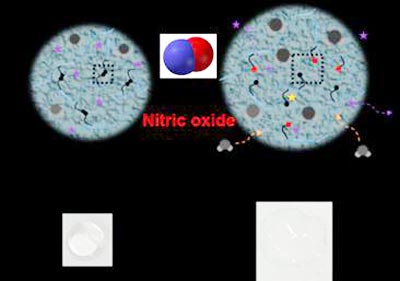Gel to fight rheumatoid arthritis

IBS scientists developed a hydrogel made of polymeric acrylamide (blue spaghetti) linked with crosslinkers (black), which can accommodate drug molecules (purple stars) within its mesh (grey). In the presence of nitric oxide (red), the linker is cleaved and the drug molecules can be released. At the same time, the gel absorbs fluid from the surroundings and swells in size. Credit: Park J. et al, Advanced Materials (2017)
IBS scientists at the Center for Self-Assembly and Complexity, within the Institute for Basic Science (IBS), invented a hydrogel to fight rheumatoid arthritis and other diseases. Published in Advanced Materials, this jelly-like material could be used to absorb extra fluids in swelling joints and release drugs.
Rheumatoid arthritis (RA) is a long-term disease that causes inflammation and deformity of the joints, and affects about 1% of the world population. In this autoimmune condition, the body's immune system attacks the soft tissue of the joints, leading to an accumulation of synovial fluid. While this clear fluid lubricates and nourishes the joints, its excess causes swelling and pain.
Immune cells at the inflamed joints are the predominant source of nitric oxide (NO), a gas with various physiological functions. “Nitric oxide is like a double-edge sword. It regulates inflammation and protects our body by killing external pathogens. However, when in excess, it is toxic and may cause RA, as well as other autoimmune diseases, cardiovascular diseases, and cancer,” explains the group leader, KIM Won Jong.
Current RA treatments are based on anti-inflammatory drugs that relieve pain and inflammation, but IBS scientists tried a more challenging approach by targeting NO itself. NO is a transient gas, which stays in circulation for less than 10 seconds, before binding to other molecules.
The research team developed a gel responsive to such fugitive molecules, using acrylamide as a base material and a new crosslinker to keep it in place. Unlike the monomeric form, polymeric acrylamide hydrogel has little toxicity and can contain a large amount of water.
In addition, the cross-linking agent (NOCCL) forms bridges between the acrylamide molecules creating a net, which can trap drug molecules inside. When NO cleaves the NOCCL bridges, the gel changes its structure, frees the drug and absorbs new liquid.
Although this is a preliminary study, the team confirmed that NOCCL crosslinking agent can selectively and sensitively react with NO. The scientists are now working on a nano-sized hydrogel in a RA mouse model. Moreover, these type of hydrogels could be useful for other diseases characterized by overexpression of NO, or maybe even as environmental sensors, since NO is also a polluting gas emitted in vehicle exhaust.
Media Contact
All latest news from the category: Life Sciences and Chemistry
Articles and reports from the Life Sciences and chemistry area deal with applied and basic research into modern biology, chemistry and human medicine.
Valuable information can be found on a range of life sciences fields including bacteriology, biochemistry, bionics, bioinformatics, biophysics, biotechnology, genetics, geobotany, human biology, marine biology, microbiology, molecular biology, cellular biology, zoology, bioinorganic chemistry, microchemistry and environmental chemistry.
Newest articles

Security vulnerability in browser interface
… allows computer access via graphics card. Researchers at Graz University of Technology were successful with three different side-channel attacks on graphics cards via the WebGPU browser interface. The attacks…

A closer look at mechanochemistry
Ferdi Schüth and his team at the Max Planck Institut für Kohlenforschung in Mülheim/Germany have been studying the phenomena of mechanochemistry for several years. But what actually happens at the…

Severe Vulnerabilities Discovered in Software to Protect Internet Routing
A research team from the National Research Center for Applied Cybersecurity ATHENE led by Prof. Dr. Haya Schulmann has uncovered 18 vulnerabilities in crucial software components of Resource Public Key…





















